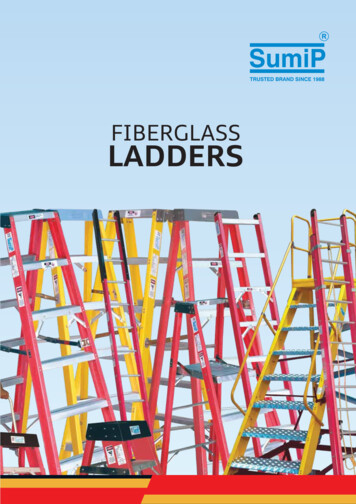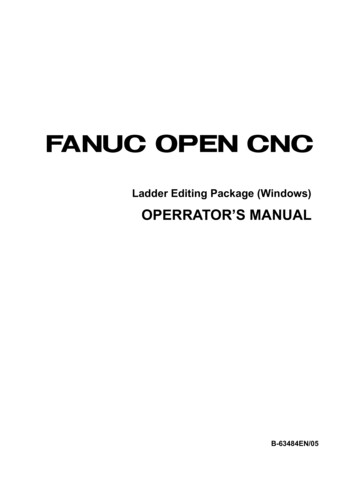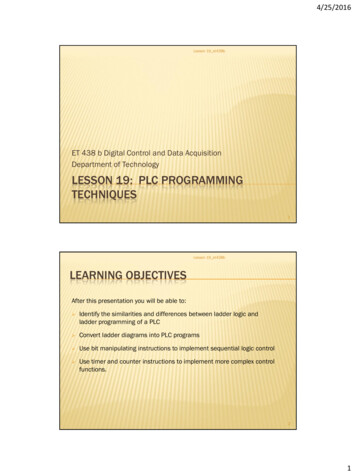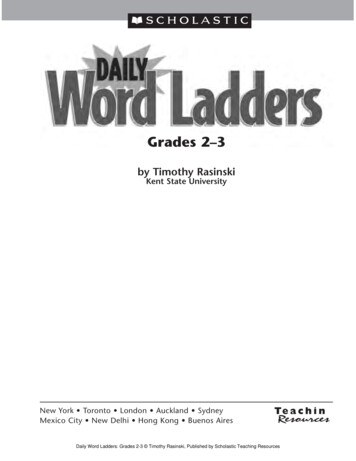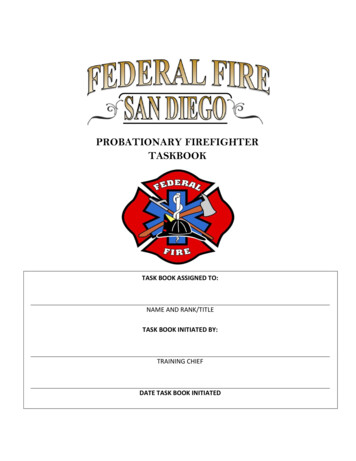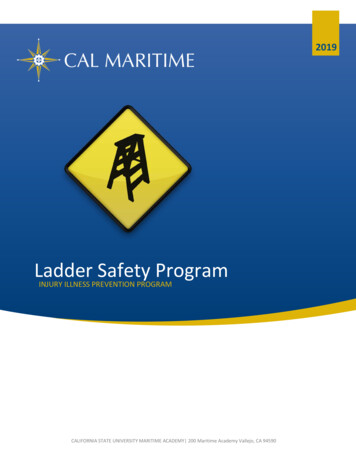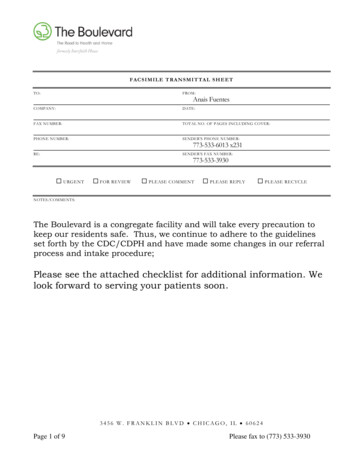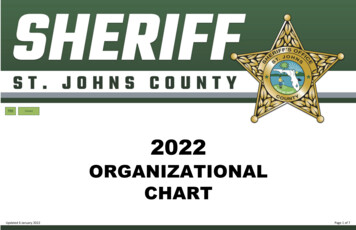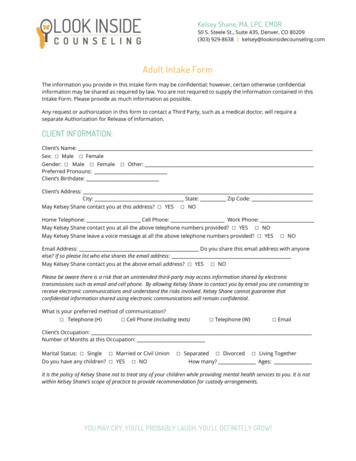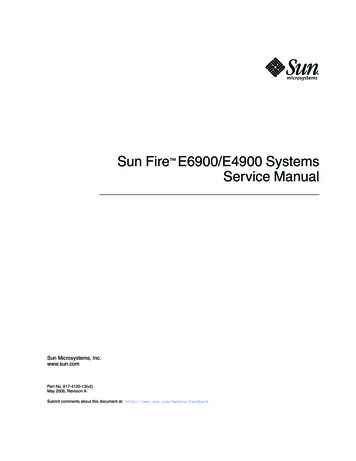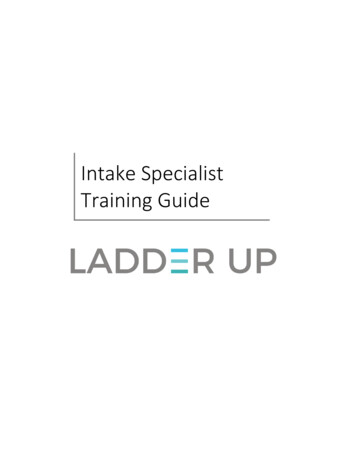
Transcription
Intake SpecialistTraining Guide
Table of ContentsOverview . 1General Site Process . 2Site Setup . 3Intake Process . 4IRS Form 13614-C Intake/Interview & Quality Review Sheet. 7Income Documents Overview . 9Expense Documents Overview . 10Screening of Schedule C Clients with Expenses . 11BASIC Common Forms for Returns . 16Form W2 (Basic or HSA) . 16Form W-2G (Basic) . 17Form 1099-INT (Basic). 18Form 1099-DIV (Basic) . 19Form 1099-R (Basic or Advanced*) . 20Form 1099-G (Basic) . 21Form SSA-1099 (Basic) . 22Form RRB-1099 (Basic). 23Form RRB-1099-R (Basic) . 24Form 1098-E (Basic) . 25Form 1098-T (Basic) . 26ADVANCED Common Forms for Returns . 27Form 1098 (Basic or Advanced*) . 27Property Tax Bill (Basic or Advanced*). 28Form 1099-B (Adv) . 29Form 1099-MISC (Adv) . 30Form 1099-K (Adv) . 32Form 1099-C (Adv) . 33Form 1099-S (Adv) . 34HSA Forms for Returns. 35Form 5498-SA (HSA). 35Form 1099-SA (HSA). 36The Affordable Care Act (ACA) and Minimum Essential Coverage (MEC) . 37Common Healthcare Forms . 38Form 1095-A (Adv) . 38Form 1095-B (Basic) . 39Form 1095-C (Basic) . 40Intake Checklist . 41Interview Checklist . 43Power of Attorney Procedures . 44
OverviewThis guide is meant to be an aide for Intake Specialists and Interviewers.This guide will allow Intake Specialists to: Understand: The roles & responsibilities of an Intake Specialist Site setup and check-in processes Become familiar with: Intake Checklist Interview Checklist Income and Interest Documents (W-2, 1098, 1099, etc.) VITA Scope of Service Health Insurance Forms (i.e. 1095-A, 1095-B, 1095-C) or certificate of exemption Intake PacketYou are NOT expected to: Be able to answer complex tax questions at a site Prepare clients’ tax returnsCertification RequirementsAll Intake Specialists must complete the following 3 credentials in order to volunteer.1. Complete the IRS Form 13615: Volunteer Standards of Conduct training and certification test2. Sign the IRS Form 136153. Complete the IRS Intake, Interview, and Quality Review (IIQR) certification testThe Ladder Up E-Learning and Certification Center is located online: goladderup.thinkific.com1
General Site ProcessStep 1: Clients sign in, and then are screened using an Intake Checklist. Eligible clients will be given Intake paperwork to fillout.Step 2: After a client’s paperwork is complete, they will meet with an Intake Specialist for an Interview. Clients should becalled by name in order of arrival based on the sign-in list. This can vary slightly site to site, but generally there is a separateintake area where clients will sit one-on-one with the Intake Specialist. Note: Some clients will need help completing theirpaperwork.Step 3: The Intake Specialist reviews the client’s paperwork and tax documents using an Interview Checklist. The interviewerwill also answer any questions the client may have and determine the scope of the return (Basic, Advanced, or out-ofscope). IRS Form 13614-C (Intake/Interview & Quality Review Sheet) should serve as a guide for this process.Step 4: Complete the top section of the TAP Supplemental Intake Form Enter the name of the site and dateCheck off whether the client has a Basic Return or Advanced returnVerify the client’s photo ID and check off the appropriate boxIf the client is returning, check the box if applicableIf the client has/had HSA, check the box if applicableIf the client requires an interpreter, check the box if applicableEnter the name of the Intake Specialist who completed the Interview Step 5: If determined to be eligible, a client will receive a WHITE index card with a number. Intake Specialist will enter theclient’s name on the Client Tracking List next to their corresponding index card number. Only clients who have beeninterviewed and determined to be eligible should be placed on the Client Tracking List. Make sure to also indicate on theClient Tracking List whether the return level is Basic or Advanced, whether the client has/had an HSA, and whether they needan interpreter.Step 6: Tax Preparers or the Site Leader will call clients up to be prepared in order of the white numbered cards. When aclient goes to a Tax Preparer (with the appropriate corresponding certification level), the Tax Preparer also collects theclient’s WHITE index card, and retires the number upside-down in a pile on the Intake/Interview table – or wherever the siteleader has deemed the cards should be placed.Step 7: When the Tax Preparer has completed the return, they will issue the client a BLUE “checker” index card (ex. C-5)which will be retired when the client is called to sit down with a Quality Reviewer.
White for Tax PreparationBlue with “C” for Quality Review “5” would be 5th in line for taxpreparation “C-5” would be 5th in line for qualityreview or “checking”If any clients are turned away, keep track of each reason in the client demand tracker section of the blueSite Leader Closing Checklist.Site Setup1.2.3.4.5.Arrive at the site to meet the Site Leader(s) one hour before the client service window beginsAsk the Site Leader to clarify the location of the Intake/Interview areaArrange intake forms, packets, and other supplies neededRemind the Site Leader to display the Civil Rights Banner and Vol Tax posterIf there are two or more Intake Specialists at the site, determine who will conduct intake (using the Intake Checklist)and who will complete interviews (using the Interview Checklist). Depending on volunteer turnout, you might needto switch roles at some point during your volunteer session.6. If clients are waiting, get started on the intake process as soon as you are set up. Generally, it is best to stay in oneplace and have the clients come to you. There are some sites where it is easier to go to the client.7. Make an announcement about general eligibility requirements to the group of waiting clients using the eligibilityposter. Also give a brief explanation of the site process.Note: If clients are waiting, please feel free to go ahead and get started on the intake process as soon as your site is set up.*Please keep in mind: You are discussing sensitive and private information with clients, so be as discreet and professionalas possible at all times.
Intake ProcessFollow the Intake Checklist. A copy is provided at the end of this guide along with examples of intake documents.Notes: Dependents need not be present, nor have photo ID verified. If the taxpayer qualifies for service, use the checkbox on the TAP Client Data Sheet to indicate you have verifiedphoto ID. Ideally, clients are screened before receiving forms to fill out; however, this is not always possible as the sites movequickly and there are not always enough volunteers to fill the need. If a client is married and intends to file a joint return, both spouses must be present at the site in order to be eligiblefor services. We cannot verify spouse identity if the spouse is not physically present at the site. At a minimum, thespouse must be present for the quality-review process. Note: there are some, rare instances where we can accept aPower of Attorney form. (Information on POA procedures is included at the end of this guide.)Acceptable proof of Tax Identification Numbers (TIN):Social Security Number (SSN)A client needs to bring the physical, original Social Security card for everyone who appears on his tax return. Oftentimes, efiled returns are rejected because of a mismatch between a name and SSN. This is also an important identity theft deterrent.Alternatives to SSN: If a client cannot provide an original Social Security card, the Site Leader may accept the followingalternatives: Social Security Benefits statement (original copy from the SS office)UNACCEPTABLE proof of SSN: W-2 or other income forms (outside of SS benefits) Prior-year tax returns (even those prepared by Ladder Up) Photocopies of Social Security cards or Medicare cards Any other documents other than those that are approvedSocial Security Card CaveatsNoteVALID FOR WORK ONLY WITH DHS AUTHORIZATIONNOT VALID FOR EMPLOYMENTMeaningIssued to individuals who are lawfully admitted the U.S. on atemporary basis who have DHS authorization to workLawfully admitted to the U.S. without authorization to workfrom DHS but need a number to receive a federal benefitor service.If a taxpayer or spouse has a card with one to of these annotations, you should inquire further about their immigrationstatus to be sure they qualify for a standard Form 1040. If they are required to file a Form 1040-NR, their return is out ofscope. See information on Resident Aliens on the next page.
Next steps:1. Review the supplemental intake sheet and make sure that none of the out-of-scope visa types is present (F, J, M orQ)2. Apply the substantial presence test. (See #2 below.)3. If client is considered a resident for tax purposes this year make sure this is not the first year of residency for taxpurposes (otherwise they are dual status and out-of-scope).Individual Taxpayer Identification Number (ITIN)Taxpayers who are not eligible for a SSN can receive an ITIN for tax-filing purposes. An ITIN is a 9-digit number formattedthe same way as a SSN, but begins with a “9” (i.e. 959-70-2966). An original ITIN card or letter is acceptable proof.If a client is not eligible for a SSN and does not have an ITIN, they can set up an appointment to apply for an ITIN bycontacting Ladder Up by calling (312) 409-1555 or e-mailing ITIN@goladderup.org.Resident AliensA person is considered a resident alien if they meet one of the following two tests for the calendar year:1. The green card test - You're considered to have met the green card test if at any time during the calendar year you were alawful permanent resident of the United States according to the immigration laws, and this status hasn't been revoked oradministratively or judicially determined to have been abandoned.2. The substantial presence test - For the purposes of this test, the term United States doesn't include U.S. possessions andterritories or U.S. airspace. The United States includes the following areas: All 50 states and the District of Columbia,The territorial waters of the United States, andThe seabed and subsoil of those submarine areas that are adjacent to U.S. territorial waters and over which theUnited States has exclusive rights under international law to explore and exploit natural resources.To meet the substantial presence test, you must have been physically present in the United States on at least:A. 31 days during the current year, andB. 183 days during the 3 year period that includes the current year and the 2 years immediately before. To satisfy the183 days requirement, count: All of the days you were present in the current year, andOne-third of the days you were present in the first year before the current year, andOne-sixth of the days you were present in the second year before the current year.
Days of Presence in the United States – Do not count the following days of presence in the United States for the substantialpresence test: Days you commute to work in the United States from a residence in Canada or Mexico if you regularly commutefrom Canada or Mexico. You commute regularly if you commute to work in the United States on more than 75% ofthe workdays during your working period in the current year.Days you're in the United States for less than 24 hours when you're in transit between two places outside theUnited States.Days you're in the United States as a crew member of a foreign vessel engaged in transportation between theUnited States and a foreign country or a U.S. possession. However, this exception doesn't apply if you otherwiseengage in any trade or business in the United States on those days.Days you intended to leave, but couldn't leave the United States because of a medical condition or medical problemthat arose while you were in the United States. Whether you intended to leave the United States on a particular dayis determined based on all the facts and circumstances.Days you're an exempt individual.Exempt Individuals – A person is considered an exempt individual if they fall into any of the following categories: An individual temporarily present in the United States as a foreign government-related individual under an A or Gvisa. However, this category doesn't include household staff of a foreign government-related individual present inthe United States under an A-3 or G-5 visa.A teacher or trainee temporarily present in the United States under a J or Q visa, who substantially complies withthe requirements of the visa. You won't be an exempt individual as a teacher or trainee if you were exempt as ateacher, trainee, or student for any part of 2 of the 6 preceding calendar years. However, you'll be an exemptindividual if all of the following conditions are met: You were exempt as a teacher, trainee, or student for any part of 3 (or fewer) of the 6 preceding calendaryears, A foreign employer paid all of your compensation during the current year, and A foreign employer paid all of your compensation during each of the preceding 6 years you were present inthe United States as a teacher or trainee.A student temporarily present in the United States under an F, J, M, or Q visa, who substantially complies with therequirements of the visa. You won't be an exempt individual as a student in the current year if you've been exemptas a teacher, trainee, or student for any part of more than 5 calendar years unless you meet both of the followingrequirements: You establish that you don't intend to reside permanently in the United States. You have substantially complied with the requirements of your visa.A professional athlete temporarily present in the United States to compete in a charitable sports event.Even if you meet the substantial presence test, you may still be treated as a nonresident alien if you're present in the UnitedStates for fewer than 183 days during the current calendar year, you maintain a tax home in a foreign country during theyear, and you have a closer connection to that country than to the United States. You can't claim a closer connection to aforeign country if you've applied for status as a lawful permanent resident of the United States, or you have an applicationpending for adjustment of status. Sometimes, a tax treaty between the United States and another country will providespecial rules for determining residency for purposes of the treaty. See Publication 519, U.S. Tax Guide for Aliens, for moreinformation about the substantial presence test.Dual-Status Tax Year - If your status changes during the year from resident alien to nonresident alien or vice versa, yougenerally have a dual-status tax year. Your tax on the income for the two periods may differ under the provisions of the lawsthat apply to each period. See Publication 519, U.S. Tax Guide for Aliens, for more information about dual-status aliens.Dual-status aliens are out-of-scope, as are non-resident aliens.
IRS Form 13614-C Intake/Interview & Quality Review Sheet The 13614-C Form must be completed for every return prepared If the client is having multiple years prepared, they must complete this form for EACH corresponding year they wish tofile. Make sure Client has filled in:-Part II: Marital StatusPart II 2: Everyone who lives with the client (including those not on the tax return) Make sure a certified volunteer completes the shaded grey section7
IRS Form 13614-C (page 2-3) Use page 2 of Form 13614-C to ensure that all relevant tax and expense documentsare accounted for. Use page 3 of Form 13614-C to ensure that all required tax documents related tohealth insurance are available Page 4 is not relevant to Ladder Up sites, as we do not use Tax Slayer software.Please make sure the Client complete the Ladder Up Consent/Disclosure formsinstead, which are included in the TAP Supplemental Intake Form.8
Income Documents OverviewThe following documents are in-scope for Ladder Up services.Client’s FormDescriptionW-2Wages and Box 7: Non-Employee Compensation, Box 2: Royalties, or Box 3: Other Income1099-KPayment Card and Third Party Network Transactions (generally Uber or Lyft drivers)1099-BCapital Gain (or loss)1099-R orRRB-1099Distribution from IRAs or Distribution from Retirement Plans1099-GUnemployment Compensation orTaxable State Tax RefundSSA-1099Social Security Benefits1095-A, B, or CHealth Insurance StatementW-2GCertain Gambling Winnings1099-CCancellation of Debt (only credit card debt is in scope for Ladder Up)1098-TTuition Statement1098-EStudent Loan Interest1098Mortgage Interest Statement9
Expense Documents OverviewClients may also have expenses that reduce their tax liability or taxable income.All clients with self-employment income should receive a “Self-Employment Expenses” worksheet (see next two pages).A list of expenses is provided below along with the corresponding supporting documents. If the client does not haveeverything, please advise him to return once all the documents have been received or collected. Education expenses Expenses for kindergarten through 12th grade are relevant for the Illinois return. Request receipts. Postsecondary education expenses are relevant for the Federal return. Request receipts.Childcare expenses Documentation must include the care provider’s Employer Identification Number (EIN). If the care provideris an individual, his/her name and SSN are required to claim expenses. Mortgage interest and real estate (property) taxes paid. Many homeowners will bring in a Form 1098 to showmortgage interest paid and a property tax bill. (The prior year tax bill is required as property taxes are paid inarrears. The deduction is for the year the bill was actually paid). However, you can also look this information uponline with the county’s Treasurers office. Medical expenses (for taxpayers that itemize their deductions) Charitable contributions ( for taxpayers that itemize their deductions)10
Screening of Schedule C Clients with ExpensesA Guide for Screeners and Advanced PreparersScreening of Schedule C clients with who have expenses that they want to deduct can be very difficult because the 13614-Cform asks if clients have expenses related to self-employment income but does not ask for details. As the details emergeduring the course of the client’s visit it may become apparent that the client is outside the scope of the program, often afterthey have spent several hours at a site. In order to expedite the process, Ladder Up has designed an additional data requestdocument for such clients that they can complete while waiting to be served. We should give the additional data request tothe client as soon as we know that they have self-employment expenses, typically during screening, or even earlier if we findout sooner.The list on the following page shows various Schedule C situations that are out of scope for VITA programs. As soon as youbecome aware of one of these, you should refer the client to a paid preparer. If in doubt, see your site leader. The soonerwe can resolve these issues, the better off both we and our clients will be.Looking at the client’s completed additional data sheet for self-employment expenses, here are some questions to look atsooner rather than later:Question #2: If the client answers “Yes” or if they run a day care center in their home, then they may be eligible to claimcertain of the expenses of their residence on their tax return. Such clients should be referred to a professional preparer.Oftentimes clients who do not fall into one of those two categories will still want to claim home office expenses. You canexplain that such clients do not meet the rules to do so and, assuming they agree, prepare their return without home officeexpenses.Question #3: Businesses where others were employed, either as employees or independent contractors, are out of scope.(Previously contract laborers who were paid less than 600 were allowed but a new restriction was added for 2017 returns).Question 4: VITA sites typically are not allowed to prepare returns for businesses with inventory. Inventory is the items thetaxpayer buys or makes for resale to others. Most such returns are out of scope. However, if a taxpayer buys items afterreceiving an order and resells them immediately as part of the order, that is not inventory and we can prepare the return.Question 5: If items are expected to last for more than a year, they typically are required to be depreciated anddepreciation is out of scope. However, for clients who make such purchases in amounts less than 2,500 per invoice or 2,500 per item (substantiated by invoice) they can elect to expense all such items purchased during the year. To do so, theclient needs to make a “Section 1.263(a)-1(f) de minimis safe harbor election” that contains the name, address, taxpayeridentification number, and a statement that the client is making the de minimus safe harbor election. Returns have to befiled timely including extensions in order to make the election. To make the election in ProSeries, click “Where do I enter”and enter “election” in the search box. A list of elections will open, and you need to look down it until you find the“Election, De Minimis Safe Harbor” line and click on it. The election form will open, and you need to click the check box tomake the election. ProSeries will handle the rest. Any other returns with purchases of items expected to last more than ayear should be referred to a paid preparer.Question 6: VITA sites are not allowed to prepare returns with actual vehicle expenses, so clients who wish to do so shouldbe referred to a paid preparer. VITA sites are also not allowed to do returns if the taxpayer used actual expenses for the carin any prior year return (look at question 6-j).Expenses over 25,000 and/or Net Losses: VITA sites are not allowed to prepare such returns. While it may not becomeapparent that the client is in one of these situations until deep into the preparation process, it is worth taking a quick look atthe revenue and expenses to make sure that you do not have an obvious problem in this area.11
What Schedule C situations are out of scope for the VITA program?The following are out of scope for Schedule C. While this list may not be all inclusive, it is provided for your awareness. Income from a hobby (an activity typically undertaken for pleasure during leisure time) or not-for-profitactivity Expenses over 25,000 Return and allowances Cost of goods sold (inventory) Expenses for employees Business use of home Contract labor Casualty losses Vehicle expenses reported as actual expenses Depreciation or asset write-offs Rental or lease expenses – vehicle leases of more than 30 days A “Yes” response indicating there is a requirement to file Form(s) 1099 Income from the manufacture, distribution, or trafficking of controlled substances (such as marijuana)Accounting methods other than the cash method Net losses A “No” response that indicates the taxpayer does not meet any of the tests of material participation, or isuncertain about materially participating in a business Taxpayers who receive any credit card or similar payments that are not includible in income12
13
14
15
BASIC Common Forms for ReturnsForm W2 (Basic or HSA)This form is used to report wages earned16
Form W-2G (Basic)The form shows gambling winnings17
Form 1099-INT (Basic)This form is used to report income from interest earned.18
Form 1099-DIV (Basic)This form is used to report dividends received.19
Form 1099-R (Basic or Advanced*)This form reports income received from pensions, annuities, and other.If the taxable amount is NOT determined in Box 2a, then this must be completed by a tax preparer with Advanced Certification.20
Form 1099-G (Basic)This form reports certain government payments.21
Form SSA-1099 (Basic)The form reports Social Security benefits, which can sometimes be taxable.If Social Security benefits are a client’s ONLY source of income, and they are not filing married separately, then the taxpayer is not required to file a return.22
Form RRB-1099 (Basic)The form reports benefits received from the Railroad Retirement Board.23
Form RRB-1099-R (Basic)The form reports benefits received from the Railroad Retirement Board.24
Form 1098-E (Basic)The form is used to report interest
All Intake Specialists must complete the following 3 credentials in order to volunteer. 1. Complete the IRS Form 13615: Volunteer Standards of Conduct training and certification test 2. Sign the IRS Form 13615 3. Complete the IRS Intake, Interview, and Quality Review (IIQR) certification test The Ladder Up E-Learning and Certification Center is .
